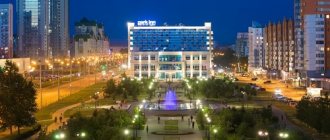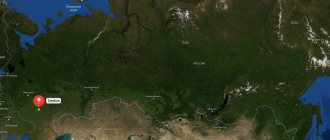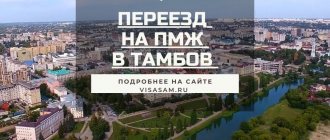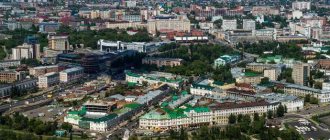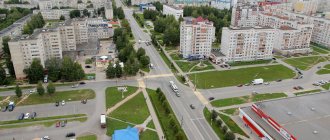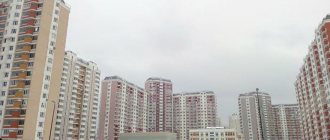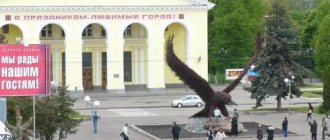| Tambov |
Tambov
, a city in Russia, the administrative center of the Tambov region and the Tambov Metropolis, the cathedral center of the Tambov diocese. Located on the Tsna River (Oka basin), 460 km southeast of Moscow. Population 283.8 thousand (2012).
- On the map: Yandex.Map, Google map
The city was founded on April 17, 1636 on the marshy, wooded banks of the Tsna River, in the place where the Studenets River merges with it. By decree of Tsar Mikhail Fedorovich, steward and governor Roman Boborykin began construction of the fortress city of Tambov to protect the Moscow state from nomads. The original name of the city was written “ Tonbov
” and was associated with the supposed site of the founding of a fortress on the Lipovitsa River “opposite the extreme Mordovian village of Tonbov” and the Tonbov River. Although the city was founded in a different place, it retained its original name. The root of the word is most likely of Moksha origin (“tonbo” - whirlpool). The fact of the founding of Tambov is reflected in an ancient chronicle written in 1788 by an unknown author.
As the borders of the Russian state moved south, Tambov by the end of the 17th century lost its former significance as a military guard fortress. In 1708, Tambov, as a district city, was assigned to the Azov province. Its connections with Moscow, the cities of the Black Earth Region and the Volga region are expanding.
In 1719, it became the center of the Tambov province, which became part of the Azov province, later (in 1732) renamed the Voronezh province. In 1779, it became the administrative center of the Tambov governorship, which in 1796 became known as the Tambov province. The province included 13 cities.
In the middle of the 19th century, the construction of stone buildings began in Tambov - a guest courtyard, government offices, a men's gymnasium and the Alexander Institute. The formation of the city center ended at the end of the 19th century with the construction of the Naryshkin reading room, the building of the State Duma and the Assembly of the Nobility.
In the 19th century, Tambov was a major center for grain wholesale trade. Industry developed slowly and in 1913 it provided only 2% of the total industrial output of European Russia. Before the October Revolution, the largest enterprises in Tambov were railway workshops (800 workers) and a candle factory (85 workers). In addition to them, there were about 30 small semi-handicraft factories.
The February and October revolutions of 1917 took place quite peacefully in Tambov.
In August 1919, during the civil war, the city was captured by the cavalry of General Mamontov. In 1920-21, the city was engulfed in a peasant uprising led by A.S. Antonov.
In 1928, the Tambov province was included in the Central Black Earth Region, and with the dissolution of the Central Black Earth Region in 1934, it was included in the Voronezh Region.
In 1937, the Tambov region was formed, which included the territory of the Penza and Tambov regions; in 1939, the boundaries of the region were revised.
During the Great Patriotic War, a large number of hospitals were opened in the city, and the city was bombed.
Religion
The Tambov diocese was founded in 1682, abolished in 1720 and restored in 1758.
By the end of the 1930s, the Tambov diocese was completely destroyed. There is not a single active parish left on its territory. The restoration of the diocese began in October 1943, when the first church was opened in Tambov.
On December 26, 2012, the Tambov Metropolis was established.
The Saints
- St. Pitirim Tambovsky (+ 1698), bishop. Tambovsky from 1685 to 1698
- St. Feofan (Govorov), Recluse (+ 1894), bishop. Tambovsky from 1859 to 1863
- Sschmch. Zechariah (Lobov) (+ 1937), archbishop. Voronezh, studied at Tambov theological schools from the 1870s to 1886.
- Sschmch. Kirill (Smirnov) (+ 1937), archbishop. Tambovsky from 1909 to 1918
- Sschmch. German (Ryashentsev) (+ 1937), bishop. b. Vyaznikovsky, native
- Sschmch. Vassian (Pyatnitsky) (+ 1940), archbishop. Tambovsky from 1930 to 1936
- Schisp. Luke (Voino-Yasenetsky) (+ 1961), archbishop. Tambovsky from 1944 to 1946
Monasteries
- Voznesensky (female)
- Kazan (male)
Temples
- Alexandra Rimskaya, at Tambov State University. G.R. Derzhavina
- “Joy of All Who Sorrow” icon of the Mother of God, Church of the Ascension Monastery
- St. George the Victorious, chapel
- John the Evangelist, baptismal church
- John Chrysostom, at the former Tambov Theological School
- John of Kronstadt, Church of the Ascension Monastery
- John the Baptist, temple of the Kazan Monastery
- Kazan Icon of the Mother of God, Cathedral of the Kazan Monastery
- Metropolitan Kirill and Luke (Voino-Yasenetsky), cross church
- Cyril and Methodius, seminary house church of the Kazan Monastery
- Lazarus of the Four Days
- Nicholas the Wonderworker at the former Tambov Theological Seminary, house church
- New Martyrs and Confessors of Russia
- Panteleimon the Healer at the hospital named after St. Luke (Voino-Yasenetsky)
- Peter and Paul
- Pitirim Tambovsky, chapel
- Protection of the Blessed Virgin Mary
- Transfiguration of the Lord, Cathedral
- Seraphim of Sarov, at the former II Tambov Theological School
- Seraphim of Sarov, in the Raduzhny microdistrict (under construction [1])
- Sophia, the Wisdom of God, at the first building of the former II Tambov Theological School (abolished)
- Trinity Life-Giving
- Dormition of the Blessed Virgin Mary, church-chapel
- Feofan the Recluse (under construction [2])
Educational establishments
- Tambov Theological Seminary
Population gain or loss according to the census
The total and official population of the city of Tambov, how many people live in it as of January 1, 2022, the number of people in each individual city district and municipality, further in the second table.
| Year | Growth/decrease population city of Tambov |
| 2017 | ↗290,365 people |
| 2018 | ↗293,661 people |
| 2019 | ↘291,663 people |
| 2020 | ↗292,140 people |
| 2021 | ↘289,701 people |
| 2022 |
Transport
Roads
The city is located on the federal highway P22 "Caspian" Moscow - Astrakhan (until December 31, 2021, the old registration number M6 is used). Travel time to Moscow by car is about six hours.
An alternative route from Moscow is along the M4 Don federal highway to Yelets, then to Lipetsk - Tambov. It is also possible to travel along the M5 "Ural" through Shatsk - Morshansk. Also near the city there are roads P119 Orel - Tambov, P208 Tambov - Penza and P193 Voronezh - Tambov.
Urban
City transport is represented by trolleybuses, buses and minibuses. On November 6, 1955, trolleybus service opened in Tambov. Trolleybus traffic is carried out on 12 routes. So-called “smart” stops have appeared in the city. On a special board, those waiting can see the time until the arrival of a particular bus or trolleybus, use a bank terminal or free Wi-Fi, make payments for utilities, cellular communications and much more. A little later, the main stops began to be equipped with electronic displays indicating the time before the vehicle arrives at the stop. As of early 2015, there were at least 50 such stops in the city.
The safety of equipment and people at such stops is ensured through 24-hour video surveillance.
There are two bus stations in the city:
- Bus station "Tambov": intraregional routes, intercity: Moscow, Tula, Penza, Kursk, Lipetsk, Voronezh, Togliatti, Saratov, Belgorod, Kursk.
- Bus station "Severny": Suburban, intraregional routes, flights to Moscow.
Railway
Tambov I station belongs to the South-Eastern Railway. To the north-west there is a line to Michurinsk, to the east and south-east there are lines to Saratov (via Rtishchevo) and Kamyshin (via Balashov). There is no electrification (Russian Railways plans to electrify the Rtishchevo – Kochetovka section). Passenger trains are served by diesel locomotives TEP70 and TEP70BS from the Rtishchevo locomotive depot. Freight trains are served by the Rtishchevo depot and the Tambov depot by diesel locomotives 2TE116.
Long-distance trains pass through the city: Tambov - Moscow, Moscow - Astrakhan, Murmansk - Astrakhan, St. Petersburg - Tambov, Novorossiysk - Tambov, Simferopol - Tambov, Anapa - Tambov, Adler - Tambov, Volgograd - Brest, Moscow - Makhachkala, Berlin - Saratov, Moscow - Alma-Ata, Moscow - Balakovo, Belgorod - Novosibirsk, St. Petersburg - Astrakhan, Kharkov - Nizhny Tagil, Tambov - Kislovodsk, etc. Tsna and Bokino stations also operate for servicing commuter trains.
Suburban trains: to Michurinsk, Oblovka, Kirsanov - diesel-powered passenger cars, rail buses.
Air transport
Tambov Airport is located in the village of Donskoye, Tambov district. From January 11, 2011 to the beginning of 2012, regular flights on the route Tambov (Donskoye) - Moscow (Domodedovo) began to be operated by Ak Bars Aero airline using a Yak-40 aircraft. Since April 2012, Moscow-Tambov flights have been operated by UTair using an ATR-72 aircraft.
Districts and real estate of Tambov
Administratively, the city is divided into three districts, the name of which is familiar to every resident of the former Soviet Union - these are Sovetsky, Oktyabrsky and Leninsky districts. The largest streets in Tambov are Sovetskaya and Karl Marx Street. These two streets also serve as the basis for transport traffic in Tambov. For example, getting from the northern part to the southern part is completely impossible without crossing the mentioned streets. That is why, during the construction of an underground pedestrian crossing on Sovetskaya Street, traffic worsened significantly.
The city is also divided into parts: northern, southern, western and eastern parts and the center itself. Living in the southern and central parts of the city is considered the most prestigious. In the northern part, over the past eight years, a large number of shops and shopping centers have appeared, and (unlike other cities) hypermarkets (Auchan, Magnit, Europe) are located in the north of the city.
Near the city there are a large number of villages, some of which are already part of the city. On the northern side are the villages of Raduzhnoe, Solnechny and Severny. On the southern part there are the villages of Bokino, Stroitel, Novy, Periksa. On Rasskazovskoye Highway there is the Prigorodny Forest, as well as the village of Novaya Lyada. In addition, on other sides the city is surrounded by the villages of Pokrovo-Prigorodnoye and Streltsy. The overwhelming number of residents of these villages work and study in Tambov.
The entire northern part has begun to be rebuilt over the last twenty years. In the mid-nineties, after Ryleev Street there was a vacant lot. Weeds grew on the territory of a popular recreation area in the northern part - Victory Park. The Apparatus Plant played an important role in the development of the Oktyabrsky district. The houses on Ryleyeva and Magistralnaya streets, in particular, were built to accommodate plant workers. For the same reason, there are several workers' dormitories on these streets.
A fairly distant distance from the city center allows us to maintain optimal prices for one square meter of space in the North of the city. Apartments in the houses that are being built here, according to government programs, are given to police officers and military personnel. The area is actively developing infrastructure, shops are being built, and several schools are operating very close by. A few years ago we solved the problem with public transport. Now the most popular routes continue moving not along Magistralnaya Street, but through Chicherin, thus making an additional circle. Due to the high pace of real estate construction, the quality of new houses, unfortunately, is significantly reduced, so you should carefully consider the choice of developer.
Some districts in Tambov are named after military units. These are the areas “Svyaz”, “Letka”, “Infantry”. “Svyaz” and “Letka” are inhabited, but rather uncomfortable and dirty areas. A fairly large area is “Polynki”. It got its name because of the Polynkovskoye cemetery - the final stop in the area. In the area there is once a large one, which carried out orders from the state. In addition to the plant, there are a large number of wholesale warehouses located near the area, and there is a railway, which adds to the unkemptness of the area.
Prices
Low real estate prices have set in the western part of the city, the area of the New Bus Station. The area has undeveloped infrastructure, for example, there are no schools or kindergartens nearby, there is also a transport problem, there are a limited number of bus routes. In second place is the Moskovsky microdistrict. The price per square meter here is about 20-25 thousand rubles. The first place in terms of real estate value is firmly occupied by the south (Dynamo) and the city center. The price of one square meter is about 40 thousand rubles. A small amount of real estate is being built here; the last to appear were two houses on Pionerskaya Street, as well as a house on Orenburgskaya, which was built for the resettlement of police officers. The southern part of the city is considered the most attractive from an environmental point of view; here is the Tsna River canal, “Friendship Park”, and a park at a cardiological sanatorium.
In recent years, villages located near the city have gained great popularity. For example, in the village of Raduzhnoe an innovative school is currently being built and shops are opening. The streets in the village have original names, unusual for the city as a whole - “Violet”, “Lesnaya”, “Vasilkovaya”. The price for a one-story cottage was set at 2 million rubles. Each house has a small plot of land and convenient access.
Ecology and climate of Tambov
The temperate continental climate of Tambov is largely determined by its location. In this climate, all seasons are clearly expressed. For 21 days in July and 20 days in January, it is the continental temperate air that determines the weather.
Thus, the average temperature in January is about -10 degrees Celsius, in July – about 25. The average annual air temperature in the region is 5.3 degrees Celsius, the annual amount of precipitation ranges from 350 to 700 mm, more than half of it (about 300 mm) falls during the warm season. The duration of the growing season is 178 days in the north and 185 days in the south.
In the region, water resources are represented by surface and underground water bodies. The rivers of the Tambov region belong to the Volga and Don basins. The largest rivers in the region are the Tsna, Vorona, and Voronezh. Artificial water bodies that partially regulate the flow of the Tsna include 10 waterworks of the Tsna lock system, which serves to supply water to industrial enterprises in Tambov and Morshansk, irrigate land and create a favorable water-air regime for floodplain agricultural land.
First of all, the state of the environment in Tambov is determined by the nature and intensity of economic entities, that is, various plants, factories and industries. In Tambov, there are over 3 thousand enterprises that can cause significant harm to the environment, including chemically
dangerous. The most significant sources of pollution in the city are “Talvis”, “Tamak” and some others.
Pollution of water bodies has a great impact on the environment. It is worth noting that groundwater is widely used in the city and region for drinking and domestic water supply. Therefore, depending on the connection, many city residents receive high-quality drinking water from underground sources, but sometimes this leads to negative consequences due to larvae entering the water supply.
Recently, according to statistics, the amount of garbage in the city has increased. Before the crisis, the city had a waste processing plant that handled part of the solid waste. However, due to the crisis, the plant temporarily suspended its activities. Despite this, the city is one of the most environmentally friendly in Russia. This is largely due to less vehicle traffic compared to large cities, and, as a result, less pollution. Tambov is a fairly green city - there are several parks and squares within its boundaries.
Story
The history of Tambov begins on April 17, 1636. On this day, the sovereign voivode Roman Boborykin founded a stronghold of the Moscow state. Thanks to economic preferences, the territory was actively populated by peasants. In 1779, by decree of Catherine II, the governorship of the same name was formed. Soon it was transformed into a province. Grain trade began to flourish there.
In the first half of the 19th century, educational and public institutions appeared. The Bolsheviks' rise to power was accompanied by peasant uprisings. The rebels seized lands and opposed the arbitrariness of the rulers.
Industrialization was marked by the commissioning of industrial enterprises. After the end of World War II, new industries emerged. Residential areas, plants, and factories were built. As part of the Russian Federation, the pace of development has slowed down.
Interesting Facts
About marriages
In the 18th–19th centuries. neither the groom nor the bride played any roles during the marriage. Everything was decided by the parents. There were frequent cases of men and women marrying at a very young age, and the man was often several years younger than the woman.
Examples:
- Kozlovsky district, village of Chelnavsky Otrozhek, 1801, single-yard son Andrei Miletin - 11 years old and his wife Praskovya Moiseeva - 20 years old;
- Morshansky district, village of Vyshenki, 1801, son of Kondrat Kharitonov Agap - 12 years old and his wife Nastasya Fedulova - 17 years old;
- Kozlovsky district, Podgornoye village, 1801, Zot Arkhipov’s son Stepan, 11.5 years old, and his wife Avdotya Mikhailova, 19 years old...
About celebrities
Born in Tambov:
- Sergei Rachmaninov – composer, pianist,
- Boris Chicherin – lawyer, philosopher, historian and publicist,
- Zoya Kosmodemyanskaya - partisan of the Great Patriotic War,
- Yuri Zhirkov is a football player, winner of the UEFA Cup, bronze medalist of the 2008 European Football Championship, champion of England.
- Alexander Pushkin’s wife Natalya Goncharova was also born in the Tambov region.
- Impressed by the city, Mikhail Lermontov wrote the poem “Tambov Treasurer” in 1838.
- Cosmonaut Sergei Volkov graduated from the Tambov Military Flight School in 1995, now disbanded.
- The governor of the Tambov province from 1786 to 1788 was Gavriil Derzhavin.
About chemical weapons
In 1920, a peasant uprising took place in the Tambov region. It is also called “Antonovsky” - after the name of one of the leaders of the uprising. The Soviet government was able to suppress it almost only a year later. This was the first time in history that the government used chemical weapons against an insurgent population.
About cinema
Feature films were shot in Tambov, including “The Fate of a Man” by Sergei Bondarchuk and “Once Upon a Time There Was a Woman” by Andrei Smirnov.
About the press
It was in Tambov that the first provincial newspaper in Russia appeared. It was called “Tambov News”.
About the Tambov wolf
The wolves settled in the Tambov region belong to the species of common gray wolves, widespread in the nature of Russia. There is no specific “Tambov” subspecies of wolf.
The Tambov wolf is one of the most popular souvenirs brought as a keepsake of Tambov by guests and residents of the city.
The expression about the Tambov Wolf gained wide all-Union fame after the film “The Rumyantsev Case” was released from cinema screens in 1955. In this film, the catch phrase sounded - “The Tambov wolf is your comrade!” This phrase was said by a police officer in response to an appeal from the artist Alexei Batalov, who played the role of a driver in the film.
Over many years of difficult and bloody struggle with the nomads, our ancestors noticed an interesting feature: horses, which formed the main striking force in the armies of the steppes, were afraid of the smell of wolves. This horse feature was skillfully used by the defenders of the Tambov strongholds. Tambov warriors went into battle against the Tatar and Nogai hordes, having previously put on fresh or untreated wolf skins over their armor. The Tatar horses sensed the scent of wolves and instinctively sought to turn back. The skin of the Tambov wolf, brought to England by some of the first merchants who visited the Russian state on trade visits, is now exhibited as an exhibit in the Museum of the British Royal Horse Guards.
During the Great Patriotic War, many wolves were forced to migrate from places disturbed by military operations to the territory of the Tambov region. Old people say that during the war the number of wolves in the Tambov region was simply enormous. Starving predators completely
lost fear of man. Even during daylight hours, wolves were not afraid to approach the house itself, attack dogs, sneak into barns and kill livestock (my grandmother also told me this).
Did you know that...
- The territory of the Tambov region can be compared with the area of Belgium and the Netherlands.
- The rivers of the Tambov region belong to the Volga and Don basin.
- at the end of the 19th century, Tambov residents drank water that was one of the best in Russia.
- Not far from Tambov there is Lake Chistoe, from which water periodically disappears. When it fills with water again, floating islands appear on it, on which rare plants grow.
- automobile traffic in Tambov began in 1911 (the first car was owned by the provincial secretary A.D. Gerasimov), in 1916 there were already 2 cars in the city.
- It is known that both sides of the street are called the same. but there is an exception. There is a street whose sides have different names. It starts from the street. Gastello, and goes north. The left side is called the street. Serov, and the right - District.
- The first buses ran in the city in 1928, and trolleybuses in 1955.
- Opposite the railway station there is now the Friendship of Peoples fountain. But it was not always so. In the 19th century there was a park there, planted with poplars, where visitors rested. And later a full-length monument to J.V. Stalin was erected there.
